Jewish Jewelry Symbols Explained
A phrase found throughout our site, this verse is taken from the ancient book Song of Songs, written by King Solomon in circa 951 BCE. Its translation is most commonly accepted as “I am my beloved’s and my beloved is mine.” While this beautiful quote is perfect for any love relationship, its intention was to refer to the everlasting love between G-d and the Jewish people. Read More.
Dreidel
A Yiddish word, dreidel is a spinning top played with during the holiday of Hanukkah. (Hebrew: Sevivon). The dreidel has four sides, each with a Hebrew letter—Nun, Gimmel, Hei, and Shin. These letters are an acronym for “Nais Gadol Haya Shum”—”A great miracle happened there.” In Israel however, the final letter is changed to a Peh, making the sentence “A great miracle happened here!”
Evil Eye
In Hebrew “Ayin Hara,” the evil eye refers to the jealousy and ill-wishes of others in the face of your success. It is common practice in some Jewish circles to quickly say “Bli ayin hara”—meaning, without the evil eye— after giving a compliment or sharing how many children you have. Evil eye jewelry, while called by that name, really refers to the “Good Eye” (in Hebrew, Ayin Tov), which is worn as an amulet to ward off the powers of other peoples’ jealousy.
Chai
In Hebrew chai (or, hai) means life. Judaism values human life above and beyond all things, and encourages us to live good and full lives. The word chai consists of two letters—Chet and Yud. Together, the numerical value adds up to 18, which itself is a meaningful number within Judaism. It’s also common, when giving a monetary gift, to give in multiples of 18—always referred to as Chai.
The Hamsa is a symbol seen throughout Middle Eastern cultures. It’s shaped like a symmetrical hand, and in Judaism often symbolizes the hand of Miriam. As the tradition goes, Moses was sent down the Nile River in a basket when he was a baby and Miriam, his sister, followed to ensure his safety. She sent forth her hand, so to speak, to protect him. Therefore the Hand of Miriam—the Hamsa—is an icon of protection for all time.
Hanukkah Menorah (Hanukkiah)
A Hanukkiah, as opposed to a general Menorah (see below), is used specifically for the holiday of Hanukkah. It has eight equal branches, one for each night of Hanukkah, with a ninth branch at a different height from the rest. We light it each year to commemorate the miracle that a tiny vessel of oil burned for eight days during the re dedication of the Holy Temple.
Also known as the Choshen Mishpat, the English translation being The Breastplate of Judgment. This was a breastplate worn by the High Priest in the times of the Holy Temple, which was set with twelve precious and semi-precious stones. Each stone possessed a different unique color and represented one of the Twelve Tribes of Israel. It is said that whenever a critical decision needed to be made, the stones would light up in a cryptic pattern which only the High Priest could decipher, revealing G-d’s will.
In Hebrew “Yerushalayim,” Jerusalem is the eternal capital of Israel. Situated right in the center of the land, Jerusalem was chosen to house both Holy Temples where the entire Jewish nation came to on pilgrimage three times a year. In ancient times it was the center of Jewish life, and till today holds immense meaning for the Jewish people. Ever since we were exiled from the land, poets and scholars have poignantly lamented the loss of the Jewish capital and the Holy Temple.
Kabbalah
The literal translation of the word Kabbalah is “that which is received.” It refers to a section of Jewish wisdom which was received together with the Torah, but remained shrouded in mystery. The main book of Kabbalah is the Zohar, written by R’ Shimon Bar Yochai in the 2nd century. It expounds on esoteric concepts such as the structure of the heavens, and supernatural beings and powers. Learn more in our blog post Kabbalistic Themes.
Kiddush
Meaning “sanctification” or “holiness,” Kiddush is a specific passage said over a cup of wine (or grape juice) to sanctify the Sabbath and Jewish holidays. Most families will purchase a special silver goblet for this purpose, called a Kiddush cup.
HaKotel Ma’aravi, the Western Wall. This is the last remaining wall that surrounded the Holy Temple in Jerusalem. It was prophesied to never be destroyed and today it still stands, over 2000 years old, despite numerous attempts for its destruction. It is the closest accessible spot we have to the Holy of Holies, the direct line to Heaven. For thousands of years Jews and Gentiles from all over the world have come to weep and pray at this holiest of sites, and leave notes to G-d in its cracks. (To learn more about this meaningful topic, see https://www.aish.com/h/9av/j/48961906.html )
Lion of Judah
In the book of Genesis, Jacob blesses each of his twelve sons while on his deathbed. The blessing he gives his son Judah (Yehuda) is that he will be like a lion and the scepter will never leave him (49:9-10). The kingship of Israel was thus destined to remain within the tribe of Judah, symbolized by a lion. When the kingdom of Israel split sometime around the 10th century BCE, only the tribes of Judah and Benjamin remained in the Jerusalem area, causing this area to become known as Judah and its people to be known as Jews. In 1949, a year after the creation of the modern State of Israel, the lion was chosen to once again be the symbol of Jerusalem. It can be seen throughout the city on its well-known coat of arms.
Menorah
While also used in Modern Hebrew as a generic term for “lamp,” the Menorah mainly refers to the giant seven-branched lampstand used in the Holy Temple. An integral part of the daily service, the Menorah would be lit daily using only the purest of olive oils. In the Hanukkah story, the first thing the Maccabees did after winning the war and reclaiming the Temple, was search for pure oil to light the holy Menorah. It has become a primary symbol of Judaism, and is used as an emblem on the coat of arms of the State of Israel.
Mezuzah
Literally “doorpost,” a mezuzah refers to an object hung on the doorposts of Jewish homes. Although a common misconception, the mezuzah does not actually refer to the case, but rather to the parchment scroll inside. On that scroll is written the holy Shema in which G-d commanded us to “write [these words] upon the doorposts of your house and upon your gates.” In order to beautify this commandment, many people will purchase beautiful cases for their mezuzah scrolls; so much so that the case itself has become somewhat of a symbol of Judaism.
In Hebrew “rimon,” the pomegranate plays a special role in Jewish custom and tradition. It is one of the seven species of Israel as listed in the Bible, and of all the fruits contains the most symbolism. For one, Jews are compared to pomegranates—the Talmud says “even the empty ones are full of mitzvot (good deeds) like a pomegranate is full of seeds.” It is also the fruit which inspired King Solomon who mentions it allegorically many times in Song of Songs, as well as letting the shape inspire the design for his crown. Perhaps the pomegranate’s most common place, however, is as the new fruit eaten on Rosh Hashanah.
Priestly Blessing
In Hebrew, “Birkat Kohanim.” The kohanim, the sons of Aaron the High Priest, were sanctified by G-d to bless the Jewish people using the following blessing: “May G-d bless you and protect you. May G-d deal kindly and graciously with you. May G-d bestow His favor upon you and grant you peace.” This was recited daily in the times of the Holy Temple, and today it is still recited by the kohanim in most synagogues.
Shabbat
Shabbat, or Sabbath, is the Jewish day of rest.  Just as G-d created the world in six days and rested on the seventh, so too He commanded us to rest on the seventh day—Saturday. Shabbat begins at sundown on Friday and it is traditionally brought in by lighting the Shabbat candles. Sterling silver candlesticks have become the traditional standard for Shabbat, beautifying the home and bringing in the warmth and specialness of Shabbat. It is a time to eat good food, spend time with family, sing and pray; and especially to take a well-deserved break from the stress of the week.
Just as G-d created the world in six days and rested on the seventh, so too He commanded us to rest on the seventh day—Saturday. Shabbat begins at sundown on Friday and it is traditionally brought in by lighting the Shabbat candles. Sterling silver candlesticks have become the traditional standard for Shabbat, beautifying the home and bringing in the warmth and specialness of Shabbat. It is a time to eat good food, spend time with family, sing and pray; and especially to take a well-deserved break from the stress of the week.
Hear O Israel, the L-rd is our G-d, the L-rd is One. This most fundamental declaration of G-d’s Oneness is said three times a day in prayer and is a cornerstone of the Jewish faith. It’s brought down in tradition that these should be the last words to leave a Jew’s mouth before he dies. It’s a proclamation of our willingness to die for the glory of G-d.
Star of David
Also known as the “Jewish star,” the Star of David is a relatively recent symbol of Judaism. Its origins are traced by some to the Middle Ages but it did not become well known as a Jewish symbol until its adoption by the Zionist movement in 1897. The star is comprised of two interlocking triangles which together form a six-pointed star (a hexagram). In Hebrew it is called a Magen David which translates to Shield of David, which is symbolic of G-d—the ultimate shield and protector. The star is emblazoned on the flag of Israel, sealing it as an eternal symbol.

Tallit
The Tallit Gadol is the prayer shawl worn during morning prayer services. It’s a large four cornered garment with Tzitzit (ritual strings) attached to each corner. It’s worn wrapped around the entire body to symbolize being enveloped and protected by G-d. However, it can slip off from time to time which is why many people will choose to purchase tallit clips—beautiful gold or silver clips attached by a chain to ensure the Tallit stays in place.





 Kotel
Kotel

Can a ring be made with “mem”, Gimal” “noon” and “hay”. We spell it “magaena” in English. Todah Rabah, Devorah
Yes sure! Please email us at baltinester@baltinesterjewelry.com with details.